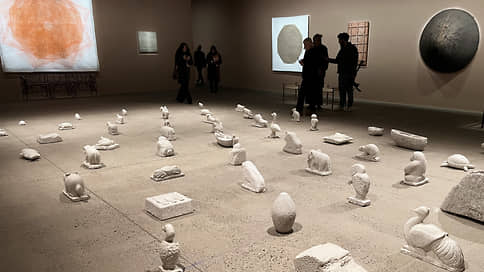An exhibition of Indian architect Bijoy Jain opened at the Fondation Cartier in Paris
[ad_1]

An exhibition of Indian architect Bijoy Jain, founder of the multidisciplinary studio Studio Mumbai and a new arch-prophet, very little known in Russia, has opened at the Fondation Cartier in Paris. Meanwhile, his approach is very close to us, says Kommersant’s correspondent in France Alexey Tarkhanov.
On the opening day of the exhibition “An Architect’s Breath” at the Fondation Cartier in Paris, Bijoy Jain was one of its most spectacular exhibits. The six-foot, 58-year-old handsome man, an athlete and a former swimmer, methodically walked around all the installations, as if checking how accurately they were silent about what he wanted to say: “When coming up with the exhibition, the curator Hervé Chandes and I wanted to talk about silence.” With equal attention, as if for the first time, he examined the semblance of a hut built in one room, woven from twigs with a red sun-moon ball inside, filled with many small sculptures, and a laconic podium made of compressed earth with a motley pattern on the floor in another room.
It seems to me that he enjoyed the glaring contrast between the restrainedly rich Western architecture represented by the glass cage of the halls of the Frenchman Jean Nouvel, and such fragile-looking multi-colored works of the Indian Studio Mumbai, complemented by the works of the Chinese woman Hu Liu and the Turkish Aleph Ebuzzia Siesby who collaborated with him on this exhibition. One made paintings for the walls, the other created sculptures placed on the floor of the halls. In the high-tech Nouvelle interior, it all looked like a fair of handicrafts. Which, by the way, was the case.
Bijoy Jain’s studio, which he founded at the turn of the century, past and present, together with his friends, Indians and Americans, indeed has very little in common with architectural firms as we are accustomed to seeing them. He himself tells how, having studied everything at US universities and worked in Britain, he came home to India to build houses. And I discovered that houses are not built here that easily. More precisely, they are not built as complicated as he intended. The local builders who received facades, plans and sections from him simply did not know how to read them, and perhaps did not know how to read them at all. But they had magical knowledge about their materials, which were not steel or concrete, but twigs, bamboo, clay, wood or cow dung. They explained to him why bamboo must be cut on a moonless night, and the broken earth must withstand rain and not turn into a sand castle. This was a revelation for the newly converted Westerner. It was then that he decided that architecture in India should not be made according to European patterns, but should be kneaded in a local trough and baked over a fire.
He has already shown the results of his observations twice, in 2010 and 2016, to Europeans at the Venice Architecture Biennale, and now for the first time he is completing a major work in France: a large wine cellar in Beaucastel in the area of the famous Chateauneuf-du-Pape, which is being built from, seemingly long-forgotten “earthbeater,” compacted and molded earth. After the Priory Palace in Gatchina, created from earthen brick by Nikolai Lvov, this material more often appeared in our country as an ersatz of normal building materials, bricks or concrete blocks. Let us recall the words of the talented Soviet architect and famous wit Andrei Burov, who, observing the hasty post-war reconstruction, made fun of the “rot-and-post buildings.”
In the West, on the contrary, the use of local materials and ancient skills has become an architectural fashion. Here you understand, by the way, what Bijoy Jain has in common with Cartier, not with the foundation, but with watchmakers. In modern watch manufactories, this is how everything happens in a close mix of modern and traditional engineering and human manual capabilities. Of course, in cool Paris with its December +13, the architecture of Studio Mumbai can only live in greenhouse conditions under the glass bell of Jean Nouvel. In this regard, it is unlikely to be useful to the cold-loving population of the middle zone. But in the Nouvelle aquarium I remembered the megalomaniac buildings of Nikolai Polissky, my old friend, Nikolsky the sloth, which he made together with village craftsmen. Carpenters and basket knitters built their Peisan towers under his leadership, never proclaiming this waste trade to be the main road of new architecture.
At Fondation Cartier, caretakers specifically warn about the extreme fragility of the installations, which are best not touched. The only exception is chairs and armchairs made of a variety of materials, stone, rough brick, woven cotton threads. Studio Mumbai is known for its furniture, which is readily purchased from craftsmen for European and American interiors. Visitors are explicitly invited to sit down, be silent, to hear “The Breath of an Architect” and to think about the exhibition, which is best understood, of course, with hindsight.
[ad_2]
Source link






